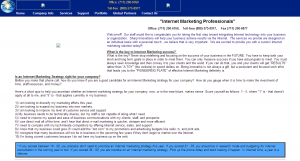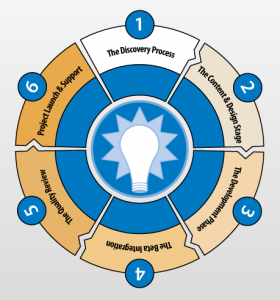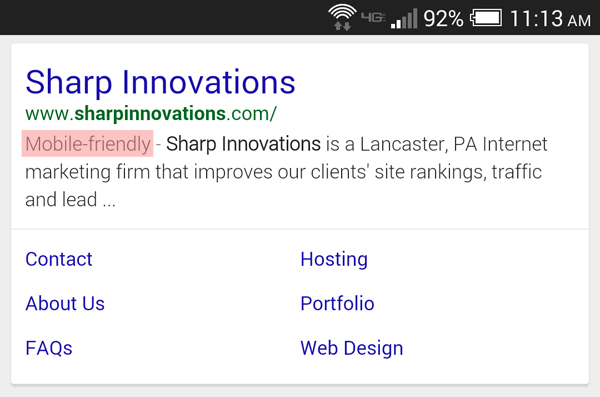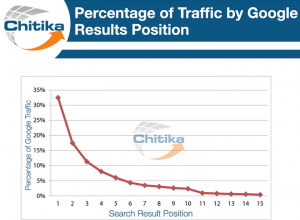Sharp Innovations Blog
Google declares: a mobile presence now significant ranking factor
March 4, 2015Customers are no longer the only ones demanding a mobile presence for your website. Following a recent post on Google’s Webmaster Central Blog, it is now clear that Google expects a mobile presence for any site that hopes to achieve top rankings. If you’ve been following our blog, or are an SEO client of ours, you know we’ve been encouraging our clients to have a user-friendly mobile presence for the past several years. And now, for the first time ever, Google is making public a change to their search algorithm, advising website owners and webmasters, developers, and others in the website building business that they have until April 21st to make their sites mobile friendly, or they may suffer search consequences:
Smaller Images Equal Faster Load Times
February 11, 2015Website page load times are important to users and search engines, alike. In both cases, loading pages faster is better—Google rankings improve, users have a better experience, and bounce rates drop. Perhaps it comes as no surprise that one way to improve page load times is to use fewer images, or use images with small file sizes. With that in mind, website development has long focused on using very few images in the actual site design (done through cascading style sheets, where possible). Nonetheless, the problem persists, because images are still widely used throughout the actual website content. There have been many solutions generated over the years to address this concern, including loading the images on-the-go as they became visible on the page. While this is a reasonable solution, it comes with the downside of users having to wait for content to become available, even after the page itself has already loaded.

Recently, there has been a lot of talk in the web design community about the usage of the “srcset” and “sizes” attributes of an image. In short, srcset allows the browser to determine which image (out of a set) is the best to use in a given situation. These “situations” that it compares are that of the viewable image size, and the pixel density of one’s browser.
Does your website qualify for Google’s new “mobile friendly” label?
November 24, 2014Google recently announced that they are taking steps to highlight websites that are particularly friendly for use on mobile devices. Not only have they started asking mobile users to rate their mobile search results, but Google has also started displaying a label in the search engine ranking pages (SERPs) that tells the user whether or not the website listed is a “mobile-friendly” one. They’ve even developed a tool to test whether or not your website is deemed “mobile friendly.”
Lancaster, PA is a Google 2014 eCity Award Recipient
November 14, 2014Not to be outdone by Lititz’s 2013 designation as the “Coolest Small Town in America,” Lancaster city was awarded Google’s 2014 eCities award for being the strongest online business community in Pennsylvania. Founded in 1999, Sharp Innovations is proud to have been one of the original web design and internet marketing firms in Lancaster, and we are now equally pleased to have contributed in earning this prestigious distinction.

In determining which cities are most deserving of this distinguished award, Google partnered with research firm Ipsos to assemble a list of the top five locations in each state that have the highest AdWords penetration relative to their population size. From this list, the firm then rated businesses within these cities based on several factors, including whether or not they commanded an online presence in the form of the following (all of which happen to be services provided by Sharp Innovations):
Get to Know Your Bounce Rate
October 29, 2014Analytics drive business decisions every day, and the same should be true for your website. Key website metrics like unique visitors and organic search performance are frequently cited data points. But something called “bounce rate,” can tell an important tale of your site’s overall performance, as well.
For the unfamiliar, bounce rate is simply the percentage of visitors who hit any page on your website and leave without moving to another page on your site. This is an important metric, because
Thinking about a new website? Ask yourself these 5 questions
October 22, 2014
Thinking about having a new website developed may seem like a daunting task. There are design aspects, content considerations, social media strategies, and any number of other variables that cause “paralysis by analysis.” But it doesn’t need to be that way.
We like to think developing a new website is much like building a new home. Before a single brick is laid, you’ll want to choose a location, select an architect, talk about your ideas, and develop a plan. Then you’ll want to meet your builders, and get the process started. At Sharp Innovations, we’ll take you through a similar process to develop a new website. When you engage in our 6 –Step Discovery Process, our team will become the architects for your website, designing a plan and guiding you through steps that involve discovery, design, content, building, quality assurance, launch, and ongoing marketing.
Flat Design: The Latest Trend is Here to Stay
September 30, 2014Design trends come and go, and some designs have a longer shelf life than others. Creating a “timeless” feel is something many designers strive to achieve, but technology can have an impact on design, due to differences in display sizes, color rendering, font standards, and more. Designers must conform to these new standards while still maintaining a classic look and ensuring effective functionality.
One trend to have emerged in the past few years is something called “flat design,” which has been adopted to an increasing extent by design-oriented companies like Apple in the iPhone and Google via Android. Car companies like Chevy and Audi have also hopped aboard the flat design bandwagon, as well.
890 Reasons to Have an Active SEO Campaign
September 15, 2014Having managed dozens (perhaps hundreds) of search engine optimization campaigns for our clients over the years, we are often asked why having an active, continuous search engine optimization (SEO) effort is preferable to just “doing SEO” once, or perhaps here and there, and then letting it go. After all, it’s entirely possible that a properly set-up site will show-up reasonably high on search engine results pages. Not only is this becoming increasingly rare (especially as your competitors become more savvy and engage in SEO efforts of their own), but imagine the impact that could be made if you actively engaged in the process! Moving up just a few positions can make a huge difference in the amount of traffic you get, as Chitika Advertising found in a 2013 study of tens of millions of online ad impressions:
HTTPS, Google and You
August 18, 2014Most people know that Google is rather secretive when it comes to how their search engine works. Indeed, outside of emphasizing the use of quality content that is user-friendly, Google generally masks any other variables that characterize their ranking process and how to reach the first page for your key business terms. This is why last week’s announcement on Google’s Online Security blog came as bit of a surprise, as Google clearly states:
Google Pigeon and Local Search Engine Optimization
August 4, 2014
About a week ago, Google released a new search algorithm update which caused one of the largest changes to local search we’ve seen. Given the nickname “Pigeon” by Search Engine Land, this update is intended to provide better local information by delivering more relevant and accurate results to the person who is doing a search. Businesses seeing benefits from this update are ones who are properly set up on the necessary directories and social media channels, and who are also fully optimized to boost their local search efforts. If you are not set-up on the major local directories or social media websites, like Google+, or if you are haven’t bothered to update the account with photos, information and the rest of the required or optional information, you will likely see a drop in both traffic and organic search referrals.

